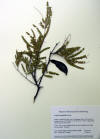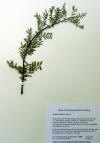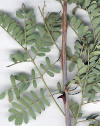|
Acacia berlandieri |
Acacia berlandieri |
|
Acacia constricta
|
Acacia constricta,
spineless form |
|
Acacia greggii
|
|
|
Acacia greggii
|
Acacia greggii |
|
Acacia koa |
|
|
Dongmo A. B., T. Miyamoto, K. Yoshikawa, S. Arihara and M. A. Lacaille-Dubois. 2007. Flavonoids from Acacia pennata and their cyclooxygenase (COX-1 and COX-2) inhibitory activities. Planta Med. 73(11):1202–1207. “Two new flavonoids quercetin 4'-O-alpha-L-rhamnopyranosyl-3-O-beta-D-allopyranoside (1) and apigenin 6-C-[2''-O-(E)-feruloyl- beta-D-glucopyranosyl]-8-C-beta-glucopyranoside (2), along with the known isorhamnetin 3-O-alpha-L-rhamnopyranoside (3), kaempferol 3-O-alpha-L-rhamnopyranosyl-(1-->4)-beta-D-glucopyranoside (4), and isovitexin (5) were isolated from the leaves of Acacia pennata Willd. (Mimosaceae) and tested for their anti-inflammatory activity. Their structures were determined by 1D and 2D NMR and mass spectrometry. They were tested for an inhibitory effect on COX-1 and COX-2, showing 60-90% inhibition at 10(-4) g/mL and 5-14% inhibition at 10(-4) g/mL, respectively.” Meena, P.D, P. Kaushik, S. Shukla, A. K. Soni, M. Kuma and A. Kuma. 2006. Anticancer and antimutagenic properties of Acacia nilotica (Linn.) on 7,12-dimethylbenz(a)anthracene-induced skin papillomagenesis in Swiss albino mice. Asian Pac. J. Cancer Prev. 7(4): 627–32. “We report the chemopreventive activity of Acacia nilotica (Linn.) gum, flower and leaf aqueous extracts, on 7,12-dimethylbenz(a)anthracene (DMBA) induced skin papillomagenesis in male Swiss albino mice. Animals were divided into following groups: Group I (Controls) given DMBA and croton oil, with no extract ; Group II (treatment) animals treated with Acacia nilotica gum (Group II-a) (800 mg/kg body weight), flowers (Group II-b) (800 mg/kg body weight), or leaves (Group II-c) (800 mg/kg body weight) during the peri- and post initiation periods of DMBA and croton oil application. A significant reduction in the values of tumor burden, tumor incidence and cumulative number of papillomas was observed in mice treated by oral gavage with the Acacia nilotica gum, flower and leaf extracts as compared with the control group. The latency period in treatment Group-II (b) and Group-II (c) was significantly increased as compared with the control group. A significant reduction in the frequency of micronuclei was also observed in mice treated by oral gavage with the aqueous extracts, along with significant decrease in total chromosomal aberrations in the form of chromatid breaks, chromosome breaks, centric rings, dicentrics, acentric fragments and exchange. Treatment with Acacia nilotica flower (Group II-B) and leaf (Group II-C) aqueous extracts by oral gavage for 15 days resulted in a highly significant decrease in the lipid peroxidation (LPO) level in the liver, but this was less evident with the gum (Group II-A) . Conversely, reduced glutathione (GSH) content was observed to be significantly elevated as compared with the control group with leaves (Group II-C) and flowers (Group II-B). The chemopreventive and antimutagenic activity of the leaf extract of Acacia nilotica was most significant followed by the flower extract and then by gum.” |
|













